American Minor
The experience of childhood in this country has changed dramatically over time. What is life like today for the typical American teenager? In the short film, American Minor, created in 2008, Charlie White portrays an intimate reality of a typical teenager, revealing a life that is both shocking and vapid. White’s depiction raises questions around who’s really raising our children. The answer might be no one.
Image courtesy of http://nyctaeus.tumblr.com/post/125951351088/american-minor-stills-charlie-white
The short film begins with an adolescent girl perched on a seemingly invisible stool amid a vast, technologically modern, white kitchen. She stares at a rabbit on the cereal box in front of her while eating the multi-colored pebbles. At one point, a gardener is seen through the window tending to the beautiful vegetation outside. The gardener’s presence and the outside world are unacknowledged by the girl as she continues to stare into her cereal box. The bold graphic colors of the cereal box transition into a sequence of colors filling the entire screen, accompanied by an unsettling melody of artificial tones. The sound/color sequences are later repeated throughout the film in different variations, signifying a new scene in the life of the minor within the locations of the house. In the next scene, the girl is sitting on the sofa staring at empty space in ultimate boredom. The discomfort of this boredom feels palpable as we watch her whiling away the time with nothing to do. A huge window reveals the rich, lush vegetation just outside, but the girl remains in her isolated environment, as if she’s trapped in a prison or a cage.
Image courtesy of http://nyctaeus.tumblr.com/post/125951351088/american-minor-stills-charlie-white
In another scene, the girl lays on pillows on the floor while watching television. We hear the chatter of teenage girl voices and canned laughter on the television while the girl eats a bowl of mixed carbs and drinks a cola. A sweaty, white geometric object is revealed in the location that the girl has been sitting, with the implication that she has become the object. In a later scene, the girl is staring into the mirror of her bathroom while brushing her hair. She stares as scenes flash on the screen of her wet and physically passionate with completely different emotions than she expresses outwardly. Aside from the gardener, the only other adult we see in the film is the housekeeper, who cleans up the cereal mess the girl left behind.
“His 2009 monograph American Minor is a collection drawing from various projects, taking a sociological stab into the collective consciousness that worships and markets the sexualized symbol of the innocent teenager.”
There’s a sense of severe isolation in this film, as the girl doesn’t seem to have any genuine connections to the world around her. The house itself feels much like a character in the film with its imposing presence that is sterile, modern and highly managed. The girl feels like an object within the house, an analogy poignantly depicted when she is transformed into the geometric sculpture. Throughout the film, there is a strong sense of her detachment to others, particularly when the girl ignores the only other two people in the film; the hired help. It’s as if they co-exist but never really interact. In addition to this detachment, there’s a sense that she lacks structure or responsibility, which is exemplified in the scene of the housekeeper cleaning up the girl’s cereal mess. The girl’s detachment and lack of responsibility seems directly related to her relationship with her parents, who are really represented by their absence in the film. Aside from the highly managed state of the home, there isn’t a sense of the parents’ presence, which leaves the impression that the girl spends much of her time alone at home.
Image courtesy of http://nyctaeus.tumblr.com/post/125951351088/american-minor-stills-charlie-white
In addition to themes about relational dynamics within the girl’s life, there are also threads involving her development and the complex experiences of adolescence. The boredom and isolation of the teenager seems to be part of the metamorphosis in transition to adulthood. Processing newly complicated feelings, hormones and sexuality are implied in her internal world, particularly in the scenes of her fantasizing about boys in her room and looking into the mirror in her bathroom.
“If we understood the teenage girl as an idea, as a phase of life in contemporary culture, then we begin to recognize it in ourselves and are able to see its expanding role in commercial society.”
A similar conceptual work to Charlie White’s American Minor, Ann Hirsch’s, Scandalishness, is a coming of age website authored by a teenage girl named Caroline. The website contains cute cat gifs, videos of Caroline dancing to her favorite songs and a page sharing the paintings that she created. The website reveals a window into the vulnerable transition into adulthood, where the girl shares her awkwardly vulnerable exploration as she searches to connect with the world. This is similar to White’s American Minor portraying the girl’s inner world as she searches to understand her role and connection with society.. A central difference in American Minor is the examination of the girl’s identity within her home life in an upper middle class setting, a prominent aspect of the film. In, Scandalishness, the website is like a personal diary portraying the interactions Caroline has with the anonymous world as she is figuring out who she is.
Charlie White’s music video, Pink, also explores the complicated transformation of adolescence to adulthood. The video features a girl that slowly becomes entirely covered in a bedazzled pink skin, a metaphorical representation of her transition into adulthood and the complex emotions that accompany the process. The video explores the confusing feelings of the loss of a former innocence to an emergence of a new and more complex way of being. American Minor is similar to Pink through the identification with the teenage girl and the confusing feelings of her unfolding sexuality as a part of adulthood. A conceptual difference from Pink is that American Minor explores the context of adolescence in the home life of an upper middle class environment. American Minor further reveals the added complications of growing up among a cultural devoid of materialism and the infatuation of youth.
White communicates an essence of the experience of modern youth that resonates with recent and upcoming generations. He also captures some alarming aspects of the lives of American adolescents; they’re alone much of the time, bored and struggling to find any connection in the world. The film depicts a worship of materialism hollowly replacing the need for human connection. Even the food in the film is empty of substance: artificial substitutions of the real. In the examination of the life of a teenage girl, a reflection of our society is also illuminated. It’s a poignant characterization of where we are in terms of American cultural ideals, values and priorities. These issues are particularly noticeable in the ways American youths spend their time and how adults regard them. The film raises several questions about the media influence on adolescents and how they’re finding meaning and value within society. One is led to ask, what type of adult is this American minor likely to become?
Cannes Festival, 2009 Official Selection
Sundance Film Festival, 2009 Official Selection
References:
http://filmmakermagazine.com/sundance_features/2009/01/crossing-over-charlie-white-by-alicia.html
http://www.kpbs.org/news/2010/oct/12/artist-charlie-whites-study-teenage-girls/
http://nyctaeus.tumblr.com/post/125951351088/american-minor-stills-charlie-white








